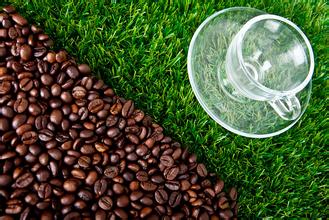Introduction to the price of Colombian coffee beans all over the world
Kenya Coffee Raw Bean Kenya AA green bean
Coffee entered Kenya in the 19th century, when Ethiopian coffee drinks were imported into Kenya through southern Yemen. But it was not until the early 20th century that the bourbon was introduced by the St. Austin Mission. Kenyan coffee is mostly grown at an altitude of 1500 to 2100 meters and is harvested twice a year. To ensure that only ripe berries are picked, people must tour the forest about seven times. Kenyan coffee is grown by small farmers. After they harvest the coffee, they first send the fresh coffee beans to the cooperative cleaning station. The washing station sends the dried coffee to the cooperative in the form of "parchment coffee beans" (that is, coffee beans covered with endocarp) to the cooperative ("parchment coffee beans" is the last state of coffee beans before peeling). All the coffees are collected together, and growers charge an average price according to their actual quality. This trading method generally works well and is fair to both growers and consumers.
Kenyan coffee beans
Hawaii Kona Extra fancy kona raw beans
A coffee producing area considered to be one of the best in the world must cover six important factors: soil quality, altitude, sunshine, cloudiness, rainfall and slope. Hawaii is blessed with these six elements to produce the best and most respected coffee in the world. Soil: fertile tropical Hawaiian volcanic soil that provides the dense nutrients of the Kona Coffee Tree. Altitude: the appropriate altitude of 2100 to 3600 meters and the cool moonlight promote the fruit of Kona Coffee to ripen slowly and create an excellent taste with rich appearance and full moisture.
Hawaiian bean
Ethiopia plus snow coffee Ethiopia Washed Yirgacheffe coffee raw beans
Medium to pointed (delicate) acidity and medium body, smooth and well balanced cup with a creamy, buttery flavor. The Cream of the Ethiopian Crop with real Mocca flavor is the representative of East African boutique coffee (specialty coffee). It has a very special and unusual aroma of citrus fruit and flowers, which makes it one of the most distinctive coffee in the world, which is rare and expensive. It is produced in the highland of sidamo province, Ethiopia (4000 feet above sea level), in a relatively high and narrow area. Yega snow coffee is of high quality that is difficult for ordinary mochas to reach, and it is also an excellent representative of African washed coffee.
Yejia Xuefei
Ethiopia (Ethiopia) mocha coffee raw bean Ethiopia mocha green bean
Arabian coffee is the hometown of Arabian coffee, which grows at high latitudes and needs a lot of manual care. Here is the famous Ethiopian mocha, which has a sour taste similar to that of wine, fragrant and productive. Ethiopia also sells coffee through the port of Mocha in neighboring Yemen across the Red Sea, so Ethiopian sun-treated coffee is often referred to as mocha. Canada in the southwest and Sidamo in the south are the main producing areas. In addition, the Eastern Highland Hara is also famous for its coffee. The beans are small and fragrant, and Hara. Mocha "Longgubeli" is a special name with a unique flavor, usually only known as "mocha". Its specification is divided into G (grade) 1-G8 according to the mixing ratio of defective beans.
Ethiopian bean
Tanzania PB coffee raw beans Tanzania coffee green bean / Peaberry garden beans, usually the best.
Most of the Tanzanian beans are grown in Mr. Kilimanjaro and Mt, near the northern Kenyan border. The Meru area, often called "Clemangaro", is occasionally named after the distribution center Moshi or Arusha. In addition, on the southern side of the border, a little washed Arabica beans are produced, named after the nearby big city Mbeya or the distribution center Pare. The way of grading is similar to that of Kenya, distinguishing sizes by the English alphabet. Most Tanzanian beans have typical African bean characteristics. The better Clemencaro, similar to ordinary Kenya, has a strong texture, is usually milder acidic than Kenya, and evenly stimulates the taste buds in the middle and sides of the back of the tongue. It tastes a bit like tomato or soda. As for southern beans, they are similar to secondary water-washed mochas, with soft and ingratiating weak acidity, round taste, and medium texture. Beans from neighboring Malawi also have the same quality as Tanzanian beans.
Capital of Tanzania
Columbia SUPREMO Coffee Raw Bean Colombia coffee green bean SUPREMO
Colombian coffee is one of the few original coffee sold in the world under the name of the country. In terms of quality, it has won praise unmatched by other coffee. The country is the world's largest exporter of Arabica coffee beans, while robusta coffee is rarely grown. It is also the world's largest exporter of washed coffee beans (Washed beans). Compared with other producing countries, Colombia is more concerned with developing products and promoting production. It is this, coupled with its superior geographical and climatic conditions, that makes Colombian coffee excellent in quality and delicious and famous all over the world.
Columbia bean
Brazilian coffee raw bean Brazil santos coffee green bean
Although Brazil produces 30 to 35% of the world's coffee annually, ranking first in the world, none of the Brazilian beans can be called the top coffee. The mountains are covered with coffee trees in southern Brazil, but Santos is the only one that can be put on the table; most of the other hastily processed beans are used to make instant coffee and easy-to-open coffee. Santos Coffee is a descendant of Arabica trees from Island of Bourbon (today's French island of Reunion, located in the Indian Ocean east of Madagascar) in the 18th century and belongs to the var subspecies. Bourbon). Before the age of three to four, Bubang coffee trees bear small, twisted beans called "Bubon Santos", the most advanced Brazilian beans, often referred to directly as "Brazil" in cafes.
Brazilian bean
North Sumatra level 1 Manning North Sumantra Mandheling Grade 1
North Sumatra is located in northern Sumatra, the fifth largest island in the world, facing the Indian Ocean to the west, the Strait of Malacca to the east, Aceh to the north, and West Sumatra to the south, with a population of about 11.3 million. Its unique geographical conditions give birth to exuberant animal and plant ecology and rich and changeable natural landscape. Manning is actually the name of a local people on the island of Sumatra. Mantenin, produced in Sumatra, is a local breed with large granules and sun treatment. it is one of the most famous and in demand coffee in the world. The local unique geological and climatic environment gives birth to unique coffee characteristics. Mantenin coffee is a favorite of heavy-flavored coffee drinkers. Its taste is delicate and full-bodied, less acidic, but bitter, rich in authentic and mellow coffee.
Manning bean
Indonesia aged Mantenin raw bean Aged Mandheling green bean
Indonesia's Sumatra Islands produces coffee, which is rich in coffee because of its unique geographical location, climatic environment, longitude and latitude. Indonesian coffee has a high mellowness, weak sour taste and strong aroma. The more famous area is Lin Dong area. Manning is also the representative of Indonesian coffee. It is worth mentioning that some coffee lovers like the so-called "Mamba Coffee", which is a mixture of Manning and Brazilian coffee. The main producing areas are Sumatra, Java and Sulawesi. 90% of them are Robbosa species, which can be rated as the first in the world in quality. Sumatra is best known for its rich, palatable and most advanced "Mantenin". In addition, "Jiayu Mountain" is also produced in the north of the island, while Java Arabica has a good sour taste, especially loved by the Dutch. Sulawesi Island is produced by a large grain of "Kalosi", represented by Delaga in the mountains of the southwest (elevation 1200 meters).
Indian bean
Indonesia Sulawesi Karosi Sulawesi Celebes Kalossi green bean
The main coffee producing areas in Indonesia (Southeast Asia) are Sumatra, Java and Sulawesi. Sulawesi (Celebes) Sulawesi, the former Dutch colony of Sulawesi, formerly known as Celebes (rapids), was named after a sailor was stranded here in 1511 because a sailor was caught in a severe storm at sea, but the present name is due to the fact that Sulawesi was rich in iron ore in the southeast of the island in the early days, so it combines the Indonesian word for Sula and Wesi. That is, it became the origin of the place name now known as Sulawesi.
Indonesian coffee beans
North Sumatra A.P. Robusta North Sumantra A.P. Robusta Grade 3
North Sumatra is located in northern Sumatra, the fifth largest island in the world, facing the Indian Ocean to the west, the Strait of Malacca to the east, Aceh to the north, and West Sumatra to the south, with a population of about 11.3 million. Its unique geographical conditions give birth to exuberant animal and plant ecology and rich and changeable natural landscape. Romda coffee trees are resistant to high temperature, cold, moisture, drought and even mold. Its adaptability is extremely strong, it can grow very well on flat land, and harvesting does not necessarily need manual work, but can be carried out completely by vibrating machines. As far as planting is concerned, growing coffee trees has many advantages, but it is a pity that the coffee beans produced have a poor aroma, bitter taste, lack of acidity, and the caffeine content is double that of Elaraby, so Romda coffee is mostly used for blending or instant coffee and beverage processing.
Sumatra Lubusta beans
Indonesia Java Robusta raw bean Indonesia Java robusta green bean
In the early 1970s, Java cut down Arabica trees introduced by most Dutch and planted Robbosa beans instead. Since then, Java coffee has become greasy, plain and has a strong smell of wheat and tea. Of the few remaining Arabica estates, Djampit is the most famous. These beans are similar to other Indonesian beans, but they are more sour and less textured. Indonesian coffee has a strong flavor, mellow taste, slightly syrup flavor and excellent acidity. Its two main export markets are Germany and Japan, which reflects the excellent quality of the coffee from the side. What attracts consumers is the unique quality of its Arabica coffee beans. You can add milk or cream to high-quality Indonesian coffee without worrying about affecting its taste.
Java Robota beans
Yunnan BM (Blue Mountain) Coffee Raw Bean
The top Yunnan coffee variety, growing at 1500 to 2000 meters, is BM coffee (bm, the most customary explanation should be the Blue Mountain coffee introduced from Jamaica), grown in Simao and Baoshan areas of Yunnan. After excellent processing, the bean shape is neat and uniform, the silver skin is very clean after washing, the content of defective beans is very small, and the texture is relatively hard. The roasted Lanshan in Yunnan does not bite like Bobang's slightly sour. At the coffee party in Shenzhen on June 24, 2006, you can also get a pot of bright, pure, full-bodied and balanced coffee with the most common mocha pot. Perfect without the bitterness of ordinary mocha pots after high temperature brewing, this is a new and amazing experience, and more than 10 people who attended the coffee party felt surprised and happy.

Important Notice :
前街咖啡 FrontStreet Coffee has moved to new addredd:
FrontStreet Coffee Address: 315,Donghua East Road,GuangZhou
Tel:020 38364473
- Prev

Fine Coffee producing areas introduce the practice of Colombian Coffee how to make Colombian Coffee delicious
Coffee from Colombia is one of the few individual coffees sold in the world under the name of the country. In terms of quality, it has won praise unmatched by other coffee. Compared with other producing countries, Colombia is more concerned with developing products and promoting production. It is this, coupled with its superior geographical and climatic conditions, that makes Colombian coffee excellent in quality and delicious and famous all over the world.
- Next

How to cook deep-baked Colombian coffee beans
Colombian coffee (Cafe de Colombia), which originated in Colombia, is one of the few individual coffees sold in the world under the name of the country. In terms of quality, it has won praise unmatched by other coffee. Compared with other producing countries, Colombia is more concerned with developing products and promoting production. It is this, coupled with its superior geographical and climatic conditions, that makes Goran
Related
- Does Rose Summer choose Blue, Green or Red? Detailed explanation of Rose Summer Coffee plots and Classification in Panamanian Jade Manor
- What is the difference between the origin, producing area, processing plant, cooperative and manor of coffee beans?
- How fine does the espresso powder fit? how to grind the espresso?
- Sca coffee roasting degree color card coffee roasting degree 8 roasting color values what do you mean?
- The practice of lattes: how to make lattes at home
- Introduction to Indonesian Fine Coffee beans-- Java Coffee producing area of Indonesian Arabica Coffee
- How much will the flavor of light and medium roasted rose summer be expressed? What baking level is rose summer suitable for?
- Introduction to the characteristics of washing, sun-drying or wet-planing coffee commonly used in Mantenin, Indonesia
- Price characteristics of Arabica Coffee Bean Starbucks introduction to Manning Coffee Bean Taste producing area Variety Manor
- What is the authentic Yega flavor? What are the flavor characteristics of the really excellent Yejasuffi coffee beans?

